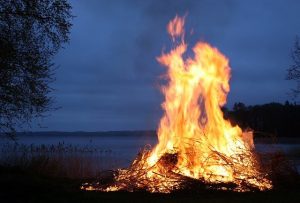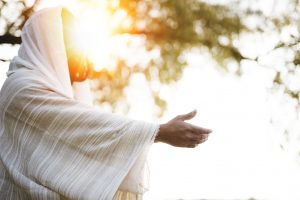
“And we beheld His glory.” John 1:14
Every Christmas, we celebrate Advent, the first coming of Jesus Immanuel, which means “God with us.” We celebrate His coming, and we celebrate how He came to dwell with us. When we do this, we are celebrating His Shekinah Glory.
Though not specifically mentioned by name in the Bible, both the Old and New Testaments record evidence of shekinah. These unique passages of Scripture illustrate how God revealed His glory. But there was no occurrence more spectacular than the one revealed in the Gospels.
God Dwells with Us
In Hebrew, Sh’cheenah, or shekinah as English speakers say, means “the dwelling” or “caused to dwell.” In Jewish thinking, it usually means He “dwelled in” or “rested upon” those whom He favored. It also is occasionally used interchangeably in the Targums (Hebrew translations or paraphrases of the Old Testament into Aramaic) with God’s holiness. We read evidence of this in Deuteronomy 23:14 when Moses told the Israelites that “the Shekinah of the Lord” walked among them.
“For the LORD your God walks in the midst of your camp to deliver you and give your enemies over to you.”
While God’s Shekinah Glory implies His holiness or divine favor, it is also His divine visitation, presence, or dwelling on the earth. One example is Elijah standing at the opening of a cave waiting for God’s approach. First came a strong wind, then an earthquake, then fire, and, ultimately, the Lord came in the form of a quiet voice (1 Kings 19:11-13).
God revisited Elijah when he challenged four hundred prophets of Baal to a showdown.
First Kings 1:20-40 describes Elijah proposing both he and all the Baal prophets burn a bull over a fire, and whosever god burned their bull first won the match. As you might recall, the Baal prophets prayed all day, but their fire wouldn’t light. When Elijah’s turn came, he first doused his wood with water, then he prayed (notice it was at the time for the evening sacrifice and not some random time of day as the other prophets did). Then the “fire of the Lord fell” and consumed not only the bull but also the wood, stones, and dust, and “licked up the water that was in the trench (v.38).
We also see God’s direct visitation when the Lord appeared as fire coming down from heaven when King Solomon dedicated the first temple.
“When Solomon had finished praying, fired came down from heaven and consumed the burnt offering and the sacrifices, and the glory of the Lord filled the temple.” 2 Chronicles 7:1
God enjoys dwelling and visiting His people, but no one had more personal visitations in the Old Testament than Moses.

Shekinah Glory Visits Moses
God’s first visit with Moses occurs in Exodus 3 when he encounters the Lord’s Shekinah Glory in the burning bush. This is the first time God personally visited anyone since Adam and Eve in the garden.
Next, God’s Shekinah Glory appears when He institutes the Passover in Exodus 12. God instructs Moses to tell the Israelites to paint a lamb’s blood on their door frames to protect them from divine judgment. That same night, God passed through Egypt, killing every firstborn child and animal, but He spared those who had the lamb’s blood on their door (v.29).
Immediately after, Pharaoh commanded the Israelites to leave. And as they wandered in the wilderness, God went before them as a pillar of cloud by day and a pillar of fire at night (Exodus 13:20-2). The Egyptian army was soon in pursuit. And when they reached the Red Sea, the chasing Egyptian army also saw God’s Shekinah Glory.
“Now it came to pass, in the morning watch, that the LORD looked down upon the army of the Egyptians through the pillar of fire and cloud, and He troubled the army of the Egyptians. And He took off their chariot wheels so that they drove them with difficulty. And the Egyptians said, ‘Let us flee from the face of Israel, for the LORD fights for them against the Egyptians.’” Exodus 14:24-25
Sometime later, God takes Aaron, Nadab, Abihu, and seventy elders, including Joshua, up Mount Sinai per God’s instructions. There, they all met God personally without being consumed by His holiness. God then commanded Moses to go farther up the mountain to receive the ten commandments.
“Then Moses went up into the mountain, and a cloud covered the mountain. Now, the glory of the Lord rested on Mount Sinai, and the cloud covered it for six days.” Exodus 24:9
His Glory is Clearly Visible
God’s Shekinah Glory was a visible sight that all could see, mainly as either a cloud or fire. But He also manifests His glory as light. It is a light so brilliant and luminous that no man can look at it without experiencing immediate death. Therefore, His glory and His presence are one, and no sin is permitted in His presence. God illustrates this in Exodus 33:18-23 when Moses asks to see His glory.
“Then He said, ‘I will make all My goodness pass before you, and I will proclaim the name of the LORD before you…You cannot see My face, for no man shall see Me and live. Here is a place by Me, and you shall stand on the rock. So it shall be, while My glory passes by that I will put you in the cleft of the rock, and I will cover you with My hand while I pass by. Then I will take away My hand, and you shall see My back. But My face shall not be seen.’”
We see additional evidence of God’s brilliance when Moses finished speaking to God in chapter 34.
“Now it was so, when Moses came down from Mount Sinai…that Moses did not know that the skin of his face shone while he talked with Him. So when Aaron and all the children of Israel saw Moses, behold, the skin of his face shone, and they were afraid to come near him.” Exodus 34:29-30
The Bible often expresses God’s Shekinah Glory and His resplendent light as the same thing, and no one had more personal knowledge of it better than Moses. That is until a baby was born in a town called Bethlehem.

The Ultimate Shekinah Glory
The prophet Isaiah prophesied Jesus’ birth thirty times over 700 years before the Lord showed up in a manger in Bethlehem. Matthew 1:23 tells us an angel spoke to Joseph, Jesus’ earthly father, and told him to name his newborn son Immanuel, which means “God with us,” thus fulfilling the prophecy told in Isaiah 7:14.
Jesus’ coming (the first of two with the second yet to come) and the proclamation that He is Immanuel is the most significant evidence of God’s Shekinah Glory. And not just evidence but the total embodiment of it.
The Jewish Encyclopedia describes Shekinah as the “created splendor of light which sometimes takes on human form.” When Jesus was born, God in the second person of the Trinity took on flesh and came to dwell (shekinah) among us.
“And the Word became flesh and dwelt among us, and we beheld His glory, the glory as of the only begotten of the Father, full of grace and truth.” John 1:14
In one amazing moment, the invisible had become visible.
Jesus was fully God and fully man at the same time. Though His glory was not readily apparent (“He had no beauty or majesty to attract us to him, nothing in his appearance that we should desire him,” Isaiah 53:2), He was and is the presence of God on earth. Paul reminds us of this in Colossians 2:9.
“For in Him dwells all the fullness of the Godhead bodily.”
The Light of the World
People in Jesus’ time knew well that Shekinah Glory is God Himself. He isn’t merely glorious; He is glory itself. The disciples recognized this tenet and associated Jesus’ light with Shekinah, that He was the manifestation of God’s glory. Their belief was solidified after Jesus’ transfiguration.
“Now after six days, Jesus Peter, James, and John, his brother, led them up a high mountain by themselves, and He was transfigured before them. His face shone like the sun, and His clothes became as white as the light.” Matthew 17:1-2
Once again, God revealed His glory to man. The transfiguration convinced the disciples that Jesus is the promised Messiah, who is “the brightness of His glory and the express image of His person (Hebrews 1:3).” Matthew 17 quickly details proof of His glory to the disciples in verse five.
“While [Peter] was still speaking, behold, a bright cloud overshadowed them. And suddenly, a voice came out of the cloud saying, ‘This is My beloved Son, in whom I am well pleased. Hear Him!’”
Jesus is the light of the world. He is the perfect expression of Shekinah Glory.

The Return of God’s Shekinah Glory
God’s Shekinah Glory—His physical presence—was made known to the Israelites in the Old Testament. And when Jesus was born, God came again to dwell with His creation. But He did not come just to dwell with them; He also came to save them. Jesus came to be the perfect sacrifice. He is the Lamb of God who takes away the sins of the world (John 1:29).
One incredible day, Jesus will return, not as a Lamb but as a Lion. It will be the second and last time the Messiah comes, but this time He will dwell with us forever. And we will behold His Shekinah Glory in its full splendor.

Baruch Atah ruach shekina El Shady Asher keterenu Aur qadash ana B’koach Amen
This was so awesome thank you so much. All Hail King Jesus! May we all see His Shekinah Glory!
May we all indeed!
WOW